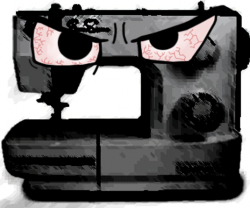Common Problems
Sewing machines are quite complicated objects inside, especially compared with most other household products. With 4 main systems and about 6 peripheral ones, there are some problems that are easy to fix at home and some other common ones where it’s best if it comes for a visit. Also remember; if it’s really stressing you out, it may be worth getting us to talk you through it anyway.

The MOST common problem: Looping.
Ever had all the thread loop under fabric? Well you and everyone else.

There are 5 possibilities:
You’ve knocked your tension dial to zero (this is how I forced the machine to sew the above sample). FIX; check your dial, reset back to approx 4 and try again.
You’ve threaded your top thread with the presser foot in the down position and it’s not going through the tension properly. FIX; make sure the presser foot is up, re-thread and try again.
There’s fluff and nonsense stuck in your tensions holding them open. FIX; grab a thin strip of fabric and “floss” it around your tension to drag anything fluff related away. Re-thread and try again.
You’ve missed your take-up leaver entirely (the metal arm that goes up and down above your needle). Check the threading diagram in your manual, carefully follow every step and try again.
There’s something actually catching underneath in the bobbin (this is most people’s first assumption and quite rare but possible). If you check your bobbin area and it looks okay, it might be time for a visit to the technician.

Skipped stitches.
There are 4 possibilities:
The most common is using the wrong needle for your fabric. More specifically, normal needles in knit or stretch fabric. For more information on correct needles see Swing Tips. FIX; choose the appropriate needle and try again.
Having the wrong thread coupled with the wrong needle. eg. You have a fine needle with upholstery thread. Check needle sizes correspond with thread weights and try again.
You don’t have the needle in the right position. FIX; undo your needle screw, make sure the needle is jammed as high as it can go and re-tighten the screw.
The timing of your machine is wrong. FIX; see a technician. The delicate balance performed by all the movements in your machine is messed up due to age, lack of service or an extreme jam up.


Bobbin threads show.
There are 4 possibilities:
You have missed your bobbin tension. FIX; re-thread the bobbin and try again.
You have wound your bobbin badly and it’s jumping around. FIX; check that your bobbin looks wound neatly with no loose ends or messiness (not too loose) but that you can still press a fingernail into the thread (not too tight). Either rewind the bobbin to fix issues or re-thread your bobbin into the machine and try again.
There’s fluff stuck in your bobbin tension. FIX; there is a way to shove the sharp corner of a piece of paper into your bobbin case tension to clean it out but if you’re not comfortable with this, you can always talk to us about the problem.
Your bobbin tension has just become too loose. FIX; tighten your bobbin tension (tighty righty, lefty loosey. Small increments). Once again, if this terrifies you, just bring it in to us.






Breaking consecutive needles.
There are 4 possibilities:
You’re not pushing your new needle up as far as it can go. FIX; adjust and try again.
What your trying to sew is too thick. FIX; try a larger (stronger) size needles. If it’s a denim seam, hit it with a hammer to spread the fibers and soften them. Use a leather needle with a piercing point. If it really is too thick, grab your balance wheel and hand wind over the tough parts.
You might be dragging the fabric too fast or pulling the fabric back yourself. FIX; let the fabric feed itself through the machine. If it is getting stuck, stop and lift your presser foot one stitch at a time rather than just pulling it through. We can tell if you do this a lot and will tell you off.
The hook may be hitting your needle. FIX; a technician. We will be able to adjust the needle position to the correct position.






Needle Unthreading
There are 2 possibilities:
If you have a mechanical machine it may just be a case of finishing the stitch properly. This means checking that the take-up leaver (the metal arm that goes up and down above your needle) is at it’s upper most position every time you finish a row of stitching. If the needle is up the top but the take-up leaver is not, the action of the take-up leaver going up pulls the cut thread out when you start again.
When cutting your threads, it’s useful to know that somewhere in your threading path there is a spring (called a check spring). If you pull too hard on your threads as you cut, the spring will bounce back and suck the thread back up through the threading path a bit. Pull, then relax your threads before cutting and leave at least a 10cm tail.






Anything is smoking or running by itself.
Just bring that hot mess in. There are 3-4 possibilities and some of them are fixable.







